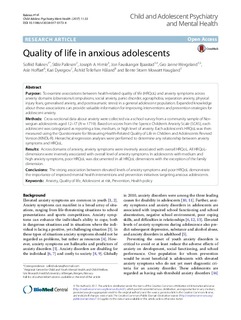| dc.contributor.author | Raknes, Solfrid | |
| dc.contributor.author | Pallesen, Ståle | |
| dc.contributor.author | Himle, Joseph A. | |
| dc.contributor.author | Bjåstad, Jon Fauskanger | |
| dc.contributor.author | Wergeland, Gro Janne | |
| dc.contributor.author | Hoffart, Asle | |
| dc.contributor.author | Dyregrov, Kari | |
| dc.contributor.author | Håland, Åshild Tellefsen | |
| dc.contributor.author | Haugland, Bente Storm Mowatt | |
| dc.coverage.spatial | Norway | nb_NO |
| dc.date.accessioned | 2019-04-03T10:50:06Z | |
| dc.date.available | 2019-04-03T10:50:06Z | |
| dc.date.created | 2017-09-16T19:39:48Z | |
| dc.date.issued | 2017 | |
| dc.identifier.citation | Raknes, S., Pallesen, S., Himle, J. A., Bjaastad, J. F., Wergeland, G. J., Hoffart, A., . . . Haugland, B. S. M. (2017). Quality of life in anxious adolescents. Child and Adolescent Psychiatry and Mental Health, 11(1). | nb_NO |
| dc.identifier.issn | 1753-2000 | |
| dc.identifier.uri | http://hdl.handle.net/11250/2593129 | |
| dc.description.abstract | Purpose
To examine associations between health-related quality of life (HRQoL) and anxiety symptoms across anxiety domains (obsessions/compulsions, social anxiety, panic disorder, agoraphobia, separation anxiety, physical injury fears, generalised anxiety, and posttraumatic stress) in a general adolescent population. Expanded knowledge about these associations can provide valuable information for improving interventions and prevention strategies for adolescent anxiety.
Methods
Cross-sectional data about anxiety were collected via a school survey from a community sample of Norwegian adolescents aged 12–17 (N = 1719). Based on scores from the Spence Children’s Anxiety Scale (SCAS), each adolescent was categorized as reporting a low, medium, or high level of anxiety. Each adolescent’s HRQoL was then measured using the Questionnaire for Measuring Health-Related Quality of Life in Children and Adolescents Revised Version (KINDL-R). Hierarchical regression analyses were performed to determine any relationship between anxiety symptoms and HRQoL.
Results
Across domains of anxiety, anxiety symptoms were inversely associated with overall HRQoL. All HRQoL-dimensions were inversely associated with overall level of anxiety symptoms. In adolescents with medium and high anxiety symptoms, poor HRQoL was documented in all HRQoL dimensions with the exception of the family dimension.
Conclusions
The strong association between elevated levels of anxiety symptoms and poor HRQoL demonstrate the importance of improved mental health interventions and prevention initiatives targeting anxious adolescents. | nb_NO |
| dc.language.iso | eng | nb_NO |
| dc.publisher | BioMed Central | nb_NO |
| dc.rights | Navngivelse 4.0 Internasjonal | * |
| dc.rights.uri | http://creativecommons.org/licenses/by/4.0/deed.no | * |
| dc.title | Quality of life in anxious adolescents | nb_NO |
| dc.type | Journal article | nb_NO |
| dc.type | Peer reviewed | nb_NO |
| dc.description.version | publishedVersion | nb_NO |
| dc.rights.holder | © The Author(s) 2017. | nb_NO |
| dc.subject.nsi | VDP::Samfunnsvitenskap: 200::Psykologi: 260 | nb_NO |
| dc.source.pagenumber | 1-11 | nb_NO |
| dc.source.volume | 11:33 | nb_NO |
| dc.source.journal | Child and Adolescent Psychiatry and Mental Health | nb_NO |
| dc.identifier.doi | 10.1186/s13034-017-0173-4 | |
| dc.identifier.cristin | 1494293 | |
| cristin.unitcode | 203,3,60,0 | |
| cristin.unitname | Institutt for sosialfag og vernepleie - Bergen | |
| cristin.ispublished | true | |
| cristin.fulltext | original | |
| cristin.qualitycode | 1 | |

